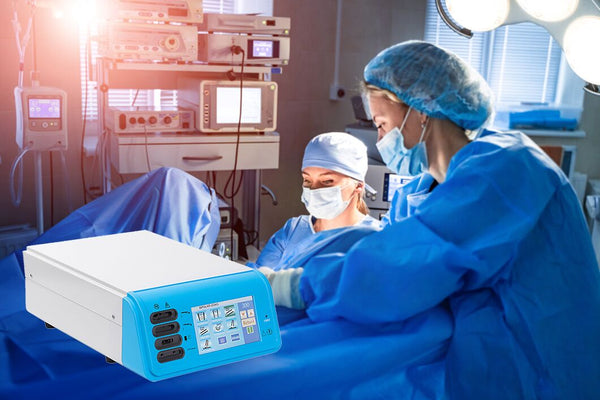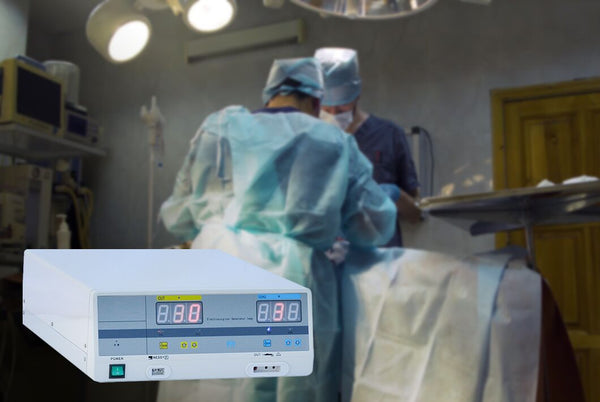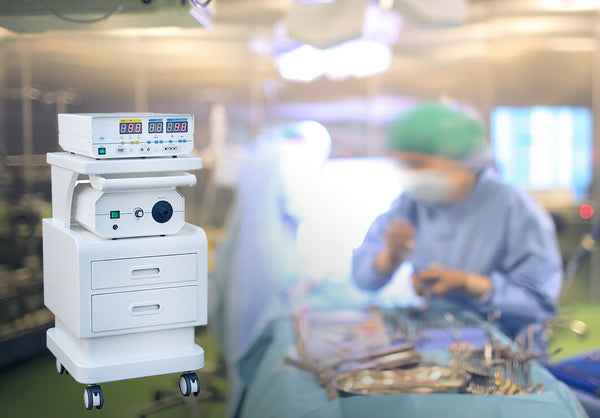Introduction
High-frequency electrosurgery has been used in clinical practice for more than 70 years since 1920. It is an electrosurgical instrument that replaces mechanical scalpels for tissue cutting. It heats body tissue through high-frequency and high-voltage current generated by the effective electrode tip, and ultimately separates and coagulates tissue to achieve the purpose of cutting and hemostasis.

Scope of application
It is not only widely used in general surgery, thoracic surgery, brain surgery, and facial surgery, but also in various endoscopic surgeries.
Advantages
Adaptable to a wide range of surgeries, easier to access the surgical site, simple to operate, safe and convenient;
Stop bleeding in time, greatly shorten the operation time, reduce the patient's blood loss and blood transfusion, thereby reducing complications and surgical costs.
Types
|
Classification |
Model |
|
Electrosurgical unit |
CNME011101A,CNME011101B,CNME011101C CNME011101D,CNME011102A,CNME011102B CNME011102C,CNME011102D,CNME011103A CNME011103B,CNME011104B,CNME011106 CNME011107,CNME011108,CNME011109,CNME011110B Use:Suitable for surgical use in general surgery, orthopedics, cardiothoracic surgery, ENT, surgery, plastic surgery, anorectal and other departments |
|
Leep Knife |
CNME011112A-leep,CNME011112B-leep Use:It is mainly used in gynecology. Compared with ordinary electrosurgical units, it is equipped with multiple smokers, and the accessories must be equipped with special gynecological (spherical, special-shaped, needle-shaped, triangular ring-shaped, etc.) electrodes. |
|
HF electrosurgical unit |
CNME011104A,CNME011105,CNME011110A CNME011110C,CNME011111,CNME011117S CNME011118,CNME011118V,CNME0111V1/CNME0111V2 Use:Suitable for surgical use in general surgery, orthopedics, cardiothoracic surgery, ENT, surgery, plastic surgery, anorectal and other departments |
|
Radiofrequency electrosurgical unit |
CNME0111RF-1,CNME0111RF-3 Use:It is a type of high-frequency electrosurgical knife with an emphasis on high frequency. It is suitable for general surgery, orthopedics, cardiothoracic surgery, ENT, surgical surgery, etc. |

Working principle
(1)Monopolar mode
In the monopolar mode, a complete circuit is used to cut and coagulate tissue. The circuit consists of a high-frequency generator within the electrosurgical unit, patient plates, connecting leads, and electrodes.
In most applications, current passes through the patient through active leads and electrodes, and then returns to the generator of the electrosurgery via the patient plate and its leads.
(2)Bipolar mode
Bipolar electrocoagulation provides high-frequency electric energy to body tissues through the two tips of bipolar forceps, causing the blood vessels between the two ends of the bipolar forceps to dehydrate and coagulate, thereby stopping bleeding.
Its scope of action is limited to the two ends of the forceps, and the degree of damage and impact on body tissues is much smaller than that of the monopolar method. It is suitable for sealing small blood vessels and fallopian tubes.
Therefore, bipolar electrocoagulation is mostly used in more delicate surgeries such as brain surgery, microsurgery, ENT, obstetrics and gynecology, and hand surgery.
The safety of bipolar electrocoagulation is gradually being recognized, and its scope of use is gradually expanding.

Structure and composition
The high-frequency electric knife is composed of a host machine and accessories such as the electric knife handle, negative plate, bipolar tweezers, and foot switch.
High-frequency electrosurgical related consumables
high-frequency electrosurgical pencil,surgical electrode,ESU plate, electrocoagulation knife
Steps
(1) Wash your hands and wear a mouthpiece.
(2) Check whether the supplies are complete.
(3) Turn on the power supply.
(4) Clean the negative plate pasting area with alcohol gauze.
(5) Open the outer packaging of the negative plate, check whether the conductive adhesive is even and complete, and stick the negative plate flat and securely on the patient's skin.
(6) Connect the negative plate connection cable, making sure that the joint is firmly connected, does not compress the patient's skin, and does not affect the surgical scope.
(7) Place the bipolar foot switch where it is convenient for the operator to use.
(8) Before starting the operation, connect the sterile electrosurgical wire to the corresponding part of the single or bipolar electrosurgery.
(9) Turn on the switch of the main unit of the electric knife. After it completes the self-test procedure, ask the doctor to press the hand control switch or step on the foot control switch to check whether the function of the electric knife is intact.
(10) Adjust the output mode and power in time according to the doctor's needs during the operation. Monopolar includes electrocution (cut) and electrocoagulation (coag). Electrocution is divided into pure cut and blended cutting. Mixed cutting is divided into spray coagulation, forced coagulation and weak coagulation. Condensation (soft).
(11) During the operation, the patient's limbs should not touch the metal parts of the operating bed, and pay attention to the patient's reaction.
(12) After the operation, turn off the power switch and disconnect the cables.
(13) Gently tear off the negative plate and check the local skin condition.
(14) Organize items.

Precautions
(1)The high-frequency electrosurgery should be carried out by a dedicated person for regular inspection, testing and maintenance. Check the integrity of the accessories and power cord before use. Do not use if any are damaged.
(2)Disconnect the power cord before cleaning. Do not use corrosive cleaning fluid or disinfectant to wipe the electric knife.
(3)The operating personnel should promptly replace damaged gloves during the operation.
(4)The negative plate of the electrosurgery should be used once. Repeated use will increase the contact resistance and increase the chance of electrical burns. It is prohibited to fold or cut the negative plate.
(5)The negative plate should be pasted on a location close to the surgical incision, easy to observe, dry, without scars, rich in muscles, and without bone protrusions. Avoid places with lack of blood supply, inflammation, rashes, etc.; avoid incisions and disinfection areas; and prevent disinfection. The liquid penetrates between the negative plate and the skin.
(6)The location of the infant negative plate should be the thighs, back, abdomen and flat muscle areas. Children under 15 kilograms should choose the infant negative plate, whose effective conductive area is 65 square centimeters.
(7)The effective conductive area of the adult negative plate is 129 square centimeters.
(8)When using the electrosurgical negative electrode circuit pad, its surface should be covered with a layer of cotton and linen fabric. The electrosurgical negative circuit pad is not suitable for patients under 12 kg.
(9)After surgical patients use mannitol for laxatives before surgery, flammable gas may be formed in the gastrointestinal tract, and there is a risk of explosion when using high-frequency electrosurgery; when using high-frequency electrosurgery near the airway, it should be temporarily removed Oxygen; when the patient has metal implants (internal fixation materials, birth control rings), the current circuit should avoid the metal implants as much as possible; equipped with a pacemaker or metal valve, built-in cardioverter defibrillator, cochlear Patients with implants and implantable mechanical pumps should avoid using unipolar electrosurgery and instead use bipolar electrocoagulation for single hemostasis; when patients with tattoos use electrosurgery, the current circuit should avoid the tattoo area; Patients with hearing aids or metal dental appliances, wigs, and jewelry need to be removed before surgery; no matter what the patient is, the current loop must avoid crossing the heart when using the electrosurgery, and the body should not come into contact with metal objects or the insulation layer between the metal bed and the patient. Should be larger than 4 cm.
